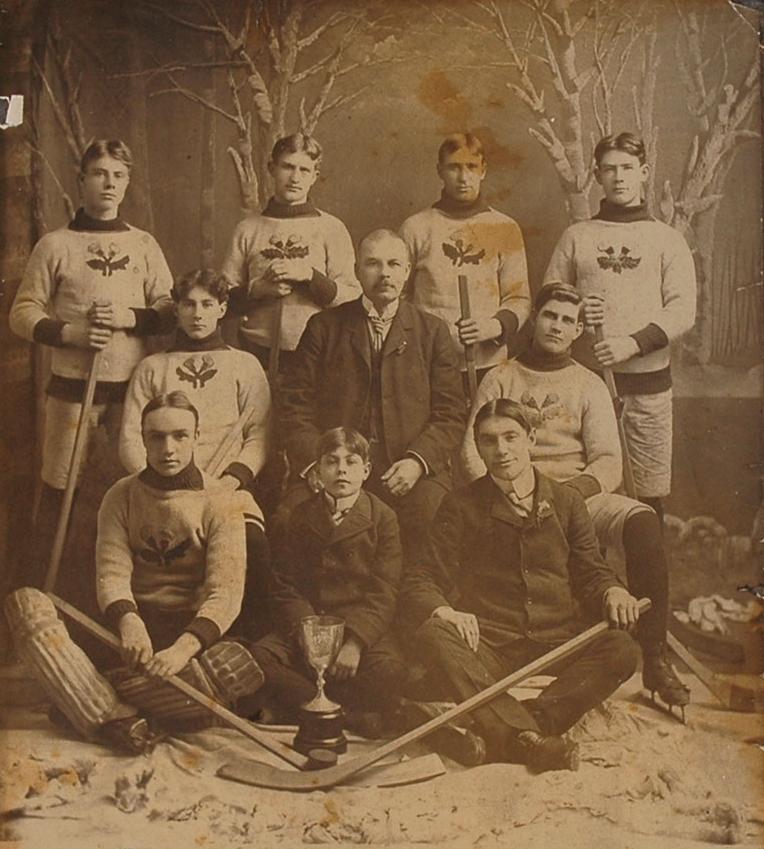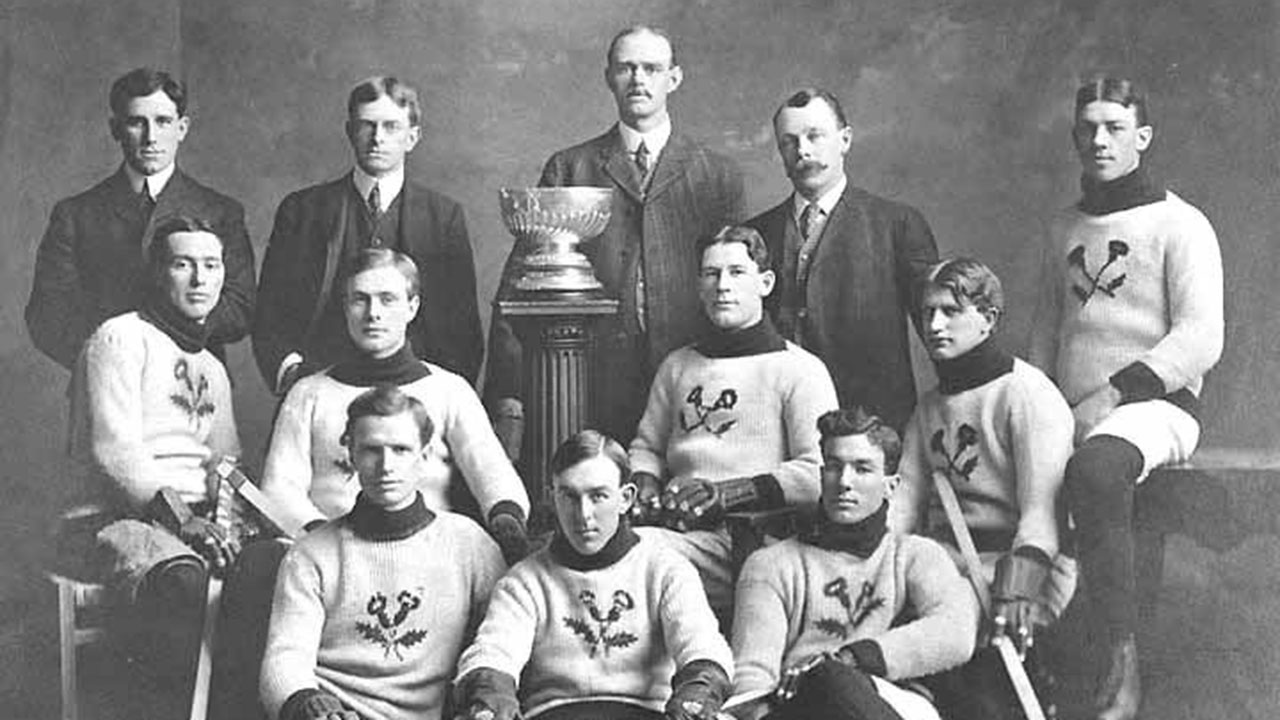Kenora has a rich hockey history. While the small community in northwestern Ontario is currently home to just over 15,000 people, it lays claim to something that has escaped the grasp of many large-market NHL cities: the Stanley Cup.
Back in 1907, the Kenora Thistles enshrined themselves into hockey lore by defeating the Montreal Wanderers in a challenge series for Lord Stanley’s chalice. At the time of the victory, the lumber-and-mining town had a population just north of 5,000, making it the smallest community ever to win the trophy.
The roots of hockey in Kenora can be traced back to the late nineteenth century when it was still known as Rat Portage. The town’s first team, the Thistles, started playing in 1894 and competed in the Manitoba Hockey Association. Within a few years, the Thistles had garnered a loyal following. So much so that the team brokered an arrangement with the Canadian Pacific Railway so that fans could travel for games of note in Winnipeg at a discounted rate.

By 1903, the Thistles had arrived in the senior division of the Manitoba and Northwestern Hockey Association (MNHA), and made an impact in their inaugural season there by winning the league championship. While regional bragging rights were nothing to scoff at back in the day, the title also gave them the opportunity to issue a challenge for the Stanley Cup.
Back then — in a period from 1893 to 1914 known as the Challenge Era — the Stanley Cup was contested among the champions of Canada’s amateur hockey leagues. Making it more interesting was that prior to 1912, teams could throw down the gauntlet at any point in the season, sometimes more than once. For example, in 1908 alone, the Montreal Wanderers successfully defend the Cup five times.
After briefly basking in their league championship in 1903, the Thistles boarded a train eastward to take on the then-Stanley Cup champion Ottawa Hockey Club, the top team from the Canadian Amateur Hockey League. Unfortunately, the weather in mid-March proved to be problematic. At the time, rinks still used natural ice and with Rat Portage taking on Ottawa so late in the season, the playing surface was a mess.
But poor ice conditions aside, reports from the Globe suggested that the Thistles were simply outmatched. According to the newspaper, the Thistles “are a big enough team and they skate fast, but they are poor stick-handlers and have absolutely no idea of combination and relied almost entirely on individual play.”
Unsurprisingly, Ottawa ended up keeping the Cup and Rat Portage returned to the Lake of the Woods empty-handed.
The Thistles would get a shot at redemption a couple years later — and once again against Ottawa. Despite starching them 9–3 in the opening game of the series, Rat Portage faltered in the next two games, which meant that the train heading back to northwestern Ontario would not be carrying any special extra cargo.
By the 1905–06 season, the Thistles had a new look to reflect the change from Rat Portage to Kenora. While the name on the sweater may have changed, the team still continued its winning ways. The Thistles racked up another league championship, but because the season ended so late they had to put their Stanley Cup challenge on hold until the following year.
The opportunity finally came in January 1907, when the Thistles found themselves once again heading eastbound, this time to take on the Montreal Wanderers for the coveted trophy. To bolster their chances, the Thistles added two future Hall of Famers to their roster, Joe Hall and Art Ross. While the former never suited up for the series, the latter was an important contributor and driver of offence.
While Kenora had not always encountered the best playing conditions on their previous eastward trips, the weather in Montreal was well suited to the Thistles’ game. On the morning of the first contest, it was 25 degrees below zero, creating the perfect sheet of ice. Kenora’s speed overwhelmed their opponents and they doubled the Wanderers up 4–2.
Now holding the advantage in the series, the Thistles went into the second contest on Jan. 21 with the opportunity to seal the deal. This time they did not disappoint.
Heading into the second half of that game — yes, at this time hockey was not yet played in periods — Kenora was up 5-2. But Montreal fought back to even the score at six-all. With four minutes remaining, however, one of the Wanderers’ best players, “Hod” Stuart, went off for tripping and Kenora made good on the advantage. They scored two more goals to add to the lead, eventually vanquishing their opponents and finally winning the Stanley Cup.

While the players undoubtedly celebrated their victory in earnest, Kenora didn’t get the chance to toast the Thistles’ achievement until nearly a month later when a public reception was held at the Hilliard Opera House. By all accounts it was a grand gathering, with many attending to pay their respects to not only the team, but to the Stanley Cup, which took centre stage at the event.
But the revelry was fleeting. The next month, the Wanderers challenged the Thistles to a rematch. The only problem was that Kenora had not finished its season in the Manitoba Hockey League and still had to take on the Brandon Wheat Cities for the championship. As a result, Stanley Cup trustee William Foran insisted that the Thistles complete their season before defending the trophy against the Wanderers.
Kenora dispatched Brandon in the playoffs on March 18 at Winnipeg Auditorium, then met the Wanderers there five days later so the Stanley Cup challenge could resume. Kenora’s own performed admirably and split the series against Montreal, but fell short on aggregate, handing the Cup back to Montreal.
The Thistles disbanded before the end of the year, but the impact they had on Kenora was enormous. With the exception of Eddie Giroux, Art Ross and Joe Hall, the team consisted entirely of local players, and the significance of a homegrown squad taking home national honours should not be understated. It invigorated a love of the sport that still continues to this day, and you can see it in the form of minor-league hockey and outdoor games on the Lake of the Woods.
While the Thistles’ Stanley Cup victory is now but a footnote in the hockey-history record books, the spirit of that achievement still lives on in Kenora.

